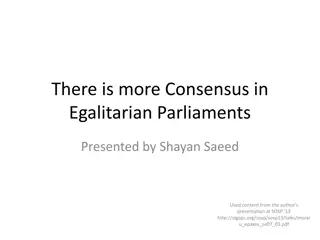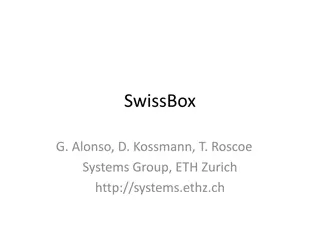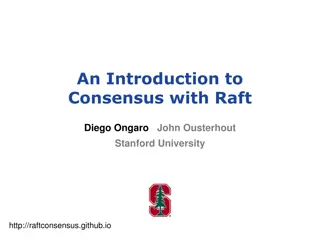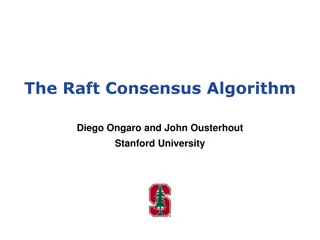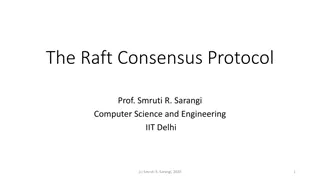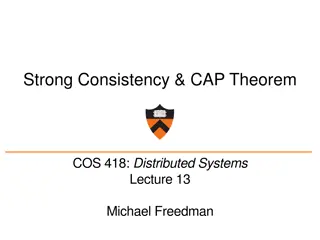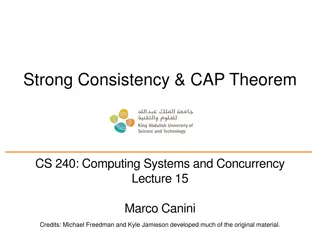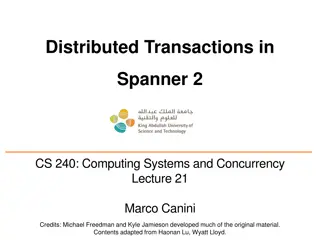The Chubby Lock Service for Distributed Systems
The Chubby Lock Service, based on the research by Mike Burrows from Google, provides a mechanism for synchronizing activities in loosely-coupled distributed systems. It allows clients to agree on basic information, such as choosing a leader, with the help of advisory locks and event notifications. T
0 views • 38 slides
Paxos and Consensus in Distributed Systems
This lecture covers the concept of Paxos and achieving consensus in distributed systems. It discusses the availability of P/B-based RSM, RSM via consensus, the context for today's lecture, and desirable properties of solutions. The analogy of the US Senate passing laws is used to explain the need fo
0 views • 46 slides
Consensus Algorithms in Paxos
Consensus algorithms play a vital role in distributed systems like Paxos. Paxos is a protocol that aims to achieve consensus among a majority of participants. It defines roles for nodes like proposers, acceptors, and learners, each serving a specific purpose in reaching agreement on a single value.
0 views • 24 slides
Consensus in Egalitarian Parliaments: Understanding EPaxos Innovation
The presentation sheds light on achieving consensus in egalitarian parliaments through EPaxos, an innovative protocol allowing concurrent commits and orderly execution. It explains the phases of the EPaxos commit protocol in detail, emphasizing the establishment of ordering constraints and the Paxos
0 views • 37 slides
Overview of SwissBox Project at ETH Zurich
SwissBox project at ETH Zurich, led by G. Alonso, D. Kossmann, and T. Roscoe, focuses on building a high-performance system called SwissBox. It encompasses hardware components like CPUs, memory, FPGAs, and storage, aiming to create a versatile computing platform. The project explores shared i-disk a
0 views • 18 slides
An Introduction to Consensus with Raft: Overview and Importance
This document provides an insightful introduction to consensus with the Raft algorithm, explaining its key concepts, including distributed system availability versus consistency, the importance of eliminating single points of failure, the need for consensus in building consistent storage systems, an
0 views • 20 slides
The Raft Consensus Algorithm: Simplifying Distributed Consensus
Consensus in distributed systems involves getting multiple servers to agree on a state. The Raft Consensus Algorithm, designed by Diego Ongaro and John Ousterhout from Stanford University, aims to make achieving consensus easier compared to other algorithms like Paxos. Raft utilizes a leader-based a
0 views • 26 slides
The Raft Consensus Protocol
The Raft Consensus Protocol, introduced by Prof. Smruti R. Sarangi, offers a more understandable and easier-to-implement alternative to Paxos for reaching agreement in distributed systems. Key concepts include replicated state machine model, leader election, and safety properties ensuring data consi
0 views • 27 slides
Strong Consistency and CAP Theorem in Distributed Systems
Strong consistency and the CAP theorem play a crucial role in the design and implementation of distributed systems. This content explores different consistency models such as 2PC, consensus, eventual consistency, Paxos, and Raft, highlighting the importance of maintaining ordering and fault-toleranc
0 views • 29 slides
Strong Consistency and CAP Theorem
Explore the concepts of strong consistency, CAP theorem, and various consistency models such as 2PC, consensus, eventual consistency, Paxos, Raft, and Dynamo. Learn about fault-tolerance, durability, and the importance of correct consistency models in distributed systems. Understand how Paxos and Ra
1 views • 29 slides
P2P Systems and Gossip Protocols in Distributed Computing
Delve into the world of P2P systems and gossip protocols through a comprehensive exploration of CAP Theorem, epidemic algorithms, managing update conflicts, and key events in distributed systems history. Learn about the prioritization of consistency versus availability, the roles of Paxos and Gossip
0 views • 61 slides
Distributed Transactions in Spanner: Insights and Mechanisms
Spanner, a strictly serializable system, leverages TrueTime for timestamping to enforce the invariant between transactions. It ensures efficient read-only transactions and multi-shard transactions. Mechanisms like 2PL, 2PC, and (Multi)Paxos contribute to Spanner's fault tolerance and scalability. Le
0 views • 21 slides
Spanner Database Overview
Spanner is a globally distributed database system that offers configurable control, consistent commit timestamps, external consistency, and TrueTime API for handling distributed data. It uses a transaction model with two-phase locking and lock-free reads, providing globally sortable timestamps. The
0 views • 19 slides



